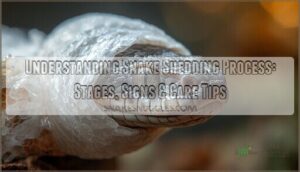This site is supported by our readers. We may earn a commission, at no cost to you, if you purchase through links.

These teeth aren’t used for chewing—they’re sharp and curved backward, perfect for grabbing and holding onto prey. Some snakes, like harmless non-venomous species, use their many tiny teeth to grip, while venomous snakes have specialized fangs for delivering venom.
What’s fascinating is that snakes constantly replace their teeth throughout their lives. So, whether it’s a hungry python or a slithering rattlesnake, their dental setup is perfectly built for survival. Curious about their unique fangs? Stick around for the details!
Table Of Contents
- Key Takeaways
- Snake Teeth Basics
- How Many Teeth Snakes Have
- Snake Dental System
- Types of Snake Fangs
- Snake Teeth Characteristics
- Frequently Asked Questions (FAQs)
- How many teeth does a snake have?
- How many teeth does a non poisonous snake have?
- How many teeth does a python have?
- What are the different types of snake teeth?
- Why do snakes have different types of teeth?
- Do venomous snakes have teeth?
- What is the Lifespan of a Snake’s Teeth?
- How Often Do Snakes Need to Replace Their Teeth?
- Are Snake Teeth Designed to Help Them Swallow Their Prey?
- How many teeth are in a snake?
- Conclusion
Key Takeaways
- Most snakes have between 50-200 teeth, with some species possessing up to 300 teeth that are curved backward to prevent prey from escaping.
- You’ll find that snake teeth aren’t used for chewing but instead serve to grip and hold prey while the snake swallows it whole—a key adaptation for their predatory lifestyle.
- Snakes continuously replace their teeth throughout their lives through a process called polyphyodont dentition, ensuring they always have sharp, functional teeth for hunting.
- Different types of snakes have specialized teeth adaptations—venomous snakes have fangs for venom delivery, while some species like egg-eaters have developed unique tooth structures or even become nearly toothless to match their specific diets.
Snake Teeth Basics
You’ll find that all snakes have teeth, with most species possessing between 50 to 200 small, curved teeth designed for gripping prey rather than chewing.
These teeth are angled backward to prevent prey from escaping once caught, allowing snakes to efficiently swallow their meals whole, which is essential for their survival and efficiently swallow.
Teeth Structure and Function
You’ve probably never examined a snake’s mouth up close, but their teeth are fascinating structures designed for efficiency.
Snake tooth structure features curved, backward-pointing teeth that function primarily for prey capture rather than chewing.
Here’s what makes snake dentition unique:
- Tooth morphology varies by species, with sizes ranging from tiny to several centimeters
- Teeth assist with swallowing mechanisms by preventing prey escape
- Dental adaptations reflect each species’ hunting style
- Evolutionary significance evident in specialized tooth arrangements
Snakes exhibit polyphyodont dentition, allowing continuous teeth replacement.
Importance of Teeth in Snakes
Snake teeth are essential for their survival.
Snake teeth, with their backward curves and sharp efficiency, are nature’s perfect tools for gripping and swallowing prey whole.
They play a key role in prey capture, holding slippery meals in place with curved, gripping precision.
Snake dentition aids the swallowing mechanism by guiding prey down the throat.
For venomous species, teeth enhance venom delivery.
These incredible dental adaptations showcase an evolutionary advantage, highlighting the remarkable survival impact of snake tooth function on their lives.
Types of Snake Teeth
There are four main types of snake teeth, each suited to their lifestyle.
Fangs, seen in venomous snakes, evolved for venom delivery. Grooved teeth help channel venom in some species.
Nonvenomous snake teeth, smaller but curved, grip prey securely. Some species, like toothless snakes, skipped teeth altogether, relying on unique diets like eggs.
Tooth morphology showcases fascinating adaptations.
How Many Teeth Snakes Have
Snakes are famous for their unique tooth arrangements, and the numbers might surprise you. Generally, most snakes have over 100 teeth! Depending on the species, this figure can range from around 50 to a staggering 300.
These tiny, backward-curved teeth are masterfully designed to grab and hold prey as they swallow it whole without chewing. Some species even possess solenoglyphous teeth function for venom injection.
Here are some highlights of snake tooth anatomy and variations:
- Tooth Development: Constant replacement guarantees functional teeth throughout their lives.
- Diet Influence: Carnivorous diets shape the sharpness and size of their teeth.
- Species Comparison: Large snakes like pythons can have more teeth than smaller species.
- Dental Anomalies: Burrowing or egg-eating snakes may have fewer teeth or none.
Teeth in snakes truly adapt to fit their evolutionary needs!
Snake Dental System
Snakes have a fascinating dental system designed to meet their hunting and feeding needs.
Their teeth are constantly replaced, and the number can vary widely based on their species and diet.
Teeth Replacement Cycle
Watching snake tooth replacement is like nature’s recycling program in action.
Teeth in snakes continuously shed and regrow throughout their lives.
Nature’s ultimate recyclers, snakes continuously shed and regrow their teeth, ensuring they never lose their edge in survival.
This maintains dental health and efficiency when hunting.
Tooth development happens quickly, with replacement frequency depending on wear and tear.
The evolutionary significance of this process highlights how snake tooth anatomy adapts for survival, keeping them ready to catch prey, which is a key aspect of their survival.
Factors Affecting Tooth Count
Snake tooth variation stems from factors like dietary influence, habitat impact, and evolutionary pressure.
Tooth size and shape adapt to prey hardness, while snake size and genetic factors shape the dental formula.
For example, burrowing species tend to have fewer teeth due to their environment.
Every detail about snake teeth showcases nature’s knack for designing perfectly adapted predators, highlighting the importance of dental formula in their survival.
Variations in Tooth Count
Tooth count varies widely among snake species due to diet, habitat, and evolutionary pressures.
While some species have fewer than 100 teeth, others boast over 200.
Habitat impacts tooth numbers, with burrowing snakes often having fewer teeth.
Age also plays a role, as younger snakes typically grow into their full dental formula over time.
Snake tooth variation showcases nature’s adaptability and highlights the importance of evolutionary pressures.
Types of Snake Fangs
Regarding snake fangs, the type and placement can tell you a lot about how they capture prey or defend themselves.
Some snakes have long, hollow fangs for injecting venom, while others rely on smaller, grooved fangs or sharp teeth for gripping, which is a key aspect of how they capture prey.
Venomous Snake Fangs
Venomous snakes have fascinating fangs designed for venom injection.
Front-fanged species, like vipers, boast longer fangs for efficiency, while backfanged snakes, such as boomslangs, evolved grooved teeth for venom delivery.
Fang morphology supports their hunting style, with venom toxicity varying greatly.
You can even purchase snake fang replicas.
Fang replacement guarantees function—new fangs grow behind the old ones, keeping nature’s most lethal predators ready to strike, with a unique system of fang replacement.
Non-Venomous Snake Teeth
Nonvenomous snakes don’t rely on venom but use their teeth for gripping prey and swallowing.
Constrictor teeth are slightly larger to assist with prey manipulation. Notably, non-fanged snakes depend entirely on their sharp teeth for their digestion role.
- Key traits of nonvenomous snake teeth:
- Small, backward-curved for grip.
- Efficient for swallowing whole prey.
- Supportive of their snake dental formula.
Their tooth morphology reflects dietary specializations.
Differences Between Species
Snake species diversity shines when comparing tooth number and fang variation.
Some species boast hundreds of teeth, while burrowing species and egg-eating snakes may have far fewer.
Diet influences snake teeth design—predators need sharp teeth, while others adapt differently.
Snake tooth variation depends on the dental formula, reflecting evolutionary needs. Truly, snakes are masters of customization!
They have a unique ability to adapt, making them highly efficient in their environments.
Snake Teeth Characteristics
You might think snake teeth are all the same, but they’re surprisingly diverse.
From sharp curves to specialized adaptations, these teeth are perfectly designed for catching prey and swallowing it whole.
Average Number of Teeth
On average, snakes boast over 100 teeth, with species averages ranging from 50 to 200 based on diet influence and size correlation.
Snake teeth are small, sharp, and arranged in curved rows, perfectly crafted for their feeding habits. Jaw placement adds to flexibility, showcasing snake dental adaptations essential for gripping prey.
Find products related to average snake teeth. No molars—just efficient tools for survival! Snake dental structure is a remarkable example of dental adaptations.
Record-Breaking Snake Teeth
Among snakes, some truly stand out in the dental department.
The Gaboon Viper boasts the largest teeth, with fangs up to two inches long.
These giants aren’t just for show—they efficiently deliver venom.
Pythons, known for their unusual dentition, have mutant teeth adapted for gripping slippery prey.
Most teeth? Some snakes sport over 200!
Fewest teeth? Specialized, toothless feeders amaze with their clever adaptations.
Unique Snake Tooth Adaptations
Some snake tooth adaptations are mind-blowing.
Egg-eater adaptations let African species swallow eggs without teeth, while burrowing species, like mole snakes, have teeth suited for underground prey.
Constrictor teeth grab and guide meals.
Fang evolution shows snakes’ creativity: sharp tools for injecting venom or gripping prey.
Toothless snakes, like Texas blind snakes, evolved specialized diets needing no teeth.
Snakes possess polyphyodont dentition, allowing continuous tooth replacement.
| Adaptation Type | Example Species | Unique Feature |
|---|---|---|
| Egg-eater Adaptations | African Egg-Eating Snake | Toothless; egg consumption |
| Constrictor Teeth | Ball Python | Holds prey tightly |
| Fang Evolution | Pit Viper | Venom injection mechanism |
Frequently Asked Questions (FAQs)
How many teeth does a snake have?
Did you know some snakes can have up to 300 teeth?
Most fall between 50 and 200, with teeth curved backward to grip prey.
It’s nature’s way of ensuring their meals never escape.
How many teeth does a non poisonous snake have?
Non-venomous snakes typically have around 100 small, sharp teeth that help grip and guide prey down their throats.
Some species may have fewer or more, depending on their size and specialized feeding habits.
How many teeth does a python have?
A python typically has around 100 sharp, backward-curving teeth.
These teeth help grip prey and guide it down the throat.
While they’re not venomous, their bite can still pack an uncomfortable punch!
What are the different types of snake teeth?
Snake teeth come in four types: aglyphous (nonvenomous, simple teeth), solenoglyphous (front-folding fangs), proteroglyphous (fixed front fangs), and opisthoglyphous (rear fangs).
Each type adapts to feeding needs like venom delivery, prey gripping, or swallowing.
Why do snakes have different types of teeth?
With up to 300 teeth, snakes adapt their dentition to catch prey.
Some inject venom, while others grip or swallow prey whole.
Different teeth types help them thrive in varying habitats and hunting styles.
Do venomous snakes have teeth?
Yes, venomous snakes have teeth, including fangs.
Their fangs are specialized for injecting venom into prey.
While some species boast larger, front-set fangs, others have smaller, rear-positioned fangs that still get the job done effectively.
What is the Lifespan of a Snake’s Teeth?
A snake’s teeth don’t last forever.
They frequently shed and replace them throughout their lives, ensuring sharpness for catching prey.
This constant replacement keeps their dental tools in tip-top shape, ready for the next meal!
How Often Do Snakes Need to Replace Their Teeth?
Like a perpetual dentist visit, snakes replace their teeth constantly throughout life.
Their teeth don’t last long due to wear and tear from grabbing prey, so replacements grow regularly, ensuring they’re always ready to hunt.
Are Snake Teeth Designed to Help Them Swallow Their Prey?
Snake teeth are absolutely designed for swallowing prey.
They’re curved backward to grip food and prevent escape, helping you slide meals down whole without chewing.
This clever design makes their unique feeding method possible.
How many teeth are in a snake?
Like a mouth full of needles, a snake’s jaw holds between 50 to 200 teeth, with most species averaging around You’ll find they’re curved backward to help trap prey more effectively.
Conclusion
As the old saying goes, there’s more than meets the eye regarding snake dentition.
Now you know how many teeth snakes have—anywhere from a few dozen to 200—and why their specialized dental structure is vital for survival.
Whether you’re fascinated by a python’s gripping teeth or a cobra’s venomous fangs, these remarkable reptiles have evolved an efficient system that perfectly suits their predatory lifestyle.
Their constant tooth replacement guarantees they’re always ready for their next meal, which is a key aspect of their predatory lifestyle.
- https://d1wqtxts1xzle7.cloudfront.net/31087800/Simoselaps1988-with-cover-page-v2.pdf?Expires=1641844146&Signature=Qz0AyRRvEM0OOis-zgLhCssd3jz9IkltSY4srybR2CLVufvKbfzCR1JRrOabrRW61jiXaSfkqCIImEuy4NZrBElJgVY30susIgLLc~E1tdN4V21WrXzHMgtXHuZ2tU83Z3hgoG4q9q-tSS36gdihmKVGv3iKwHE8l4Nm-IFZ31jHwFbvI9BonbKkID521KfGP~ideRIhJhEpvKMaYfndSlyHLsGQImQ0vN~AX2LGI8fyoimOaZUj0mt131863NOsUEuGQmQQFieRLBAAkrtlNUneF3cN-OsmCJzHlvvx2keE8LOylyUIT6aw2MUznyFhpqDbSmR~jU-RwUQT00Ie4w__&Key-Pair-Id=APKAJLOHF5GGSLRBV4ZA
- https://www.chem.fsu.edu/chemlab/chm1020c/Lecture%2010/01.php
- https://www.livescience.com/7551-snakes-fangs.html
- https://www.nationalgeographic.com/animals/reptiles/facts/snakes-1
- https://www.sciencedirect.com/topics/agricultural-and-biological-sciences/boa-constrictor















